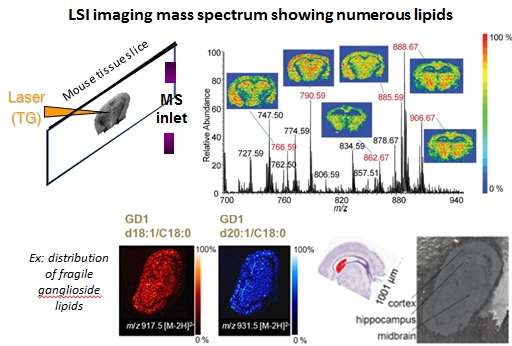Technology Summary: Laser Spray Ionization (LSI) is a novel inlet ionization method for mass spectrometry invented at WSU which can be used to create predominately multiply charged ions from solid samples at atmospheric pressure. Unlike MALDI ionization methods which are typically limited to producing singly charged species for larger molecules, LSI produces ions similar to Electrospray Ionization (ESI) methods without the need for a solvent or voltage. With higher charged ions, LSI extends the mass range (m/z) for high MW analytes which is typically limited in high resolution mass spec instruments. For example proteins such as lysozyme (MW 14 kDa) and cytochrome C (12 kDa) are easily detected on a SYNAPT G2 instrument that has a mass limit of 8000. Highly charged ions also enable improves fragmentation using electron transfer dissociation (ETD), collision induced dissociation (CID) or electron capture dissociation (ECD). The LSI process is also sufficiently soft to preserve structural integrity and permit separation according to the different shapes which is particularly beneficial for analysis of complex mixtures of component when combined with ion mobility spectrometry (IMS).
Applications:
• Analysis of lipids, proteins & peptides
• Analysis of Insoluble proteins, membrane interactions
• Protein-protein and protein-drug interaction
Numerous embodiments have been investigated including transmission and reflection geometries, as well as extending the method from atmospheric to vacuum pressures. Measured sensitivities have been in the low femtomole amounts. Particularly for drug development the LSI method is suitable for imaging intact tissue samples with proof-of-concept trial showing resolution down to 15 micron spots capable of detecting small molecules, lipids, peptides and large proteins from mouse brain tissue slices.

LSI Benefits:
● Multiply-charged ions from solid samples
● Extends mass range (m/z ratio)
● Improves fragmentation (ETD, CID, ECD)
● Improves IMS gas-phase separation
● High sensitivity (femtomoles)
● Solvent free sample prep
● Single shot – ultra fast imaging
● Improved resolution(<20 microns)
Stage of Development:
Prototype Field Free Transmission Geometry Source developed and tested on numerous samples demonstrated in multiple publications. Method extended to work from atmospheric pressure through vacuum (LSIV) adaptable to numerous manufacture instruments (e.g. Water SYNAPT, Thermo Orbitrap. Given matrix-assisted laser desorption/ionization (MALDI) is limited to singly charged species and can easily break fragile bonds (such as the glycosdic bond linking sialic acid in gangliosides) or form metal adducts, the more gentle LSI method has a great potential to expand imaging in drug development.
Patent Status: Multiple Patents Pending
• PCT/US2010/037311 “Mass Spectrometry Using Laserspray Ionization”
• PCT/US2011/050150 “System and Method for Ionization of Molecules for Mass Spectrometry and Ion Mobility Spectrometry”
• PCT/US2011/057769 Systems And Methods Extending The Laserspray Ionization Mass Spectrometry Concept From Atmospheric Pressure To Vacuum
Imaging References:
2012 “Localization and imaging of gangliosides in mouse brain tissue sections by laserspray ionization inlet” Journal of Lipid Research 53 (7) pp1390-1398
2011 “Laserspray Ionization, a New Method for Protein Analysis Directly from Tissue at Atmospheric Pressure with Ultrahigh Mass Resolution and Electron Transfer Dissociation” Mol Cell Proteomics 10(2)
2011 “Imaging mass spectrometry in transmission geometry” Rapid Commun. Mass Spectrom. 25, pp815–820
2010 “Automated Solvent-Free Matrix Deposition for Tissue Imaging by Mass Spectrometry” Analytical Chemistry 82 (1) pp359-367
2009 “Field-free transmission geometry atmospheric pressure matrix-assisted laser desorption/ionization for rapid analysis of unadulterated tissue samples” Rapid Commun. Mass Spectrom. 23 (18) pp3023-3027